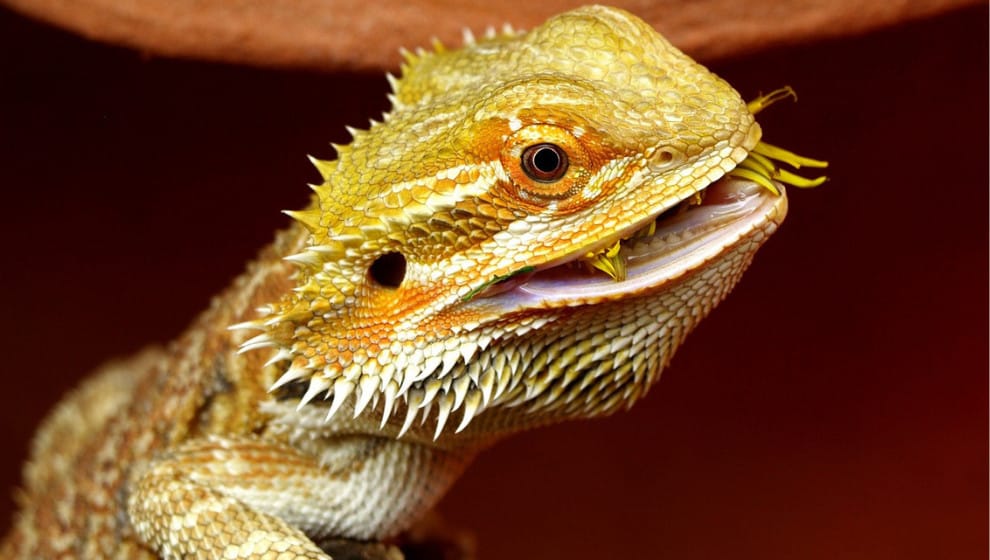If someone asks about the most popular reptile as a pet, the answer without any doubt will be Bearded Dragon. For anyone who wants to have a lizard as a pet, a Bearded dragon is the best option for him. Bearded dragons are easy to handle and get very touchy with their owners. Unlike other lizards that are active at night, bearded dragons stay awake the whole day, climb branches and sit on the logs to bask themselves in the sunlight.
Bearded dragons have distinguishing traits and characteristics that make them the best pets. These dragons have pouch-like skin folding under their necks covered with spiny projections, giving a similar look to a man’s beard. That is why they are named “Bearded Dragons.”
Table of Contents
How Long Do Bearded Dragons Live?
There is one of the main reasons behind Bearded prominent being the most favorite reptile pet and is their long life span. The average life span of the bearded dragon is 8 to 15 years in captivity. This range can vary depending upon how the owner is taking care of them, and also a variety of genetic factors is also involved in determining their life span.
What Factors Affect The Lifespan Of Bearded Dragons?
How long bearded dragons live depends upon many factors, including their diet, how they are cared for, where they live, gender, genetics, their diet, medical care, and environmental factors.
It would be the best if you always remember that there is no guarantee to the lifespan of bearded dragons (or any other pet). Your pet can fall victim to a nasty luck illness even after cared for very well by you.
If speaking statistically, you can improve the lifespan of your bearded dragon by doing the right things.
Diet
The quality of food you feed to your pet can help them stay healthy and combat diseases, thus increase their lifespan. If you want your bearded dragon to live a long life, a well-balanced and nutritious diet will help you. As bearded dragons are omnivores means they need both plant-based and animal-based diets.
The diet of dragons varies according to their age. As young dragons need a high protein diet; thus, they should be given 80% insects and 20% greens and vegetables. They reach their maturity when they turn ten months old. When your dragon is done growing, you will give them less protein in their diet, so 80% of greens and vegetables and 20% of insects should be fed.
Insects to feed them include moths, crickets, dubia roaches, slugs, cockroaches, earthworms, silkworms, grasshoppers, and spiders.
It isn’t easy to make your bearded dragon feed vegetables. Still, it would be the best if you try giving them various plant-based foods, including kale, mustard greens, collard greens, broccoli, parsnips, parsley, cucumbers, mushrooms, green beans, zucchini, asparagus, pumpkin, corn, peas, and celery.
Your pet will love to eat fruits, but fruits should not be over 10% of their diet, no matter how old they are. Fruits you can give include peaches, apricots, mangoes, apples, grapes, tomatoes, watermelon, and pineapples.
Enclosure And Habitat
To stay healthy, your bearded dragon needs a proper habitat setup. The setup you provide them should mimic their natural environment. Properly maintained temperature, lighting, and humidity level is needed for their increased lifespan.
Their enclosure’s size matters a lot. For baby dragons 80 liters tank, a 160 liters tank for juvenile dragon (10-16 inches long), a 200-300 liters tank for an adult (16-20 inches long), and a 300-500 liters tank for adult bearded dragons (more than 20 inches long).
The substrate you use for your pet makes a difference in their health. Particle and non-particle substrates can be used for your lizard’s enclosure. But you should be careful as particle substrate will produce dust and debris that, if your lizard ingests, will lead them to impaction. Impaction will cause serious health issues and may cause death if it’s not taken care of. If the particle substrate gets into the nose and eyes of your pet will lead to infection.
So, non-particle substrates like reptile carpet, newspaper, ceramic tile, and non-adhesive linoleum are considered safe for bearded dragons.
That will be the best if you put a hide in their tank, as they love crawling into them to sleep, and it will help them during brumation.
Humidity And Temperature Conditions
If you want a lengthy lifespan for your lizard, you must keep their enclosure at the right temperature. Both, a more relaxing spot and a basking spot are essential. Temperature also varies according to their age and also on what time of day it is.
For babies basking temperature should be 100-110oF, for juveniles and adults 96-100oF, for cooler spot temperature should be 80-90oF and 75-80oF for juvenile and adult bearded dragons. At night temperature of their tank should be 70-75oF for all ages.
With basking light, UVA/UVB light source is also essential to be in their tank. Light will help your lizard to digest their food. Your pet will become if the light source is not provided to them.
A humidity level below 40 degrees is needed. Failing to give this humidity level can cause respiratory problems in them, so you can measure their tank’s humidity level using a hygrometer.
Gender
Male bearded dragons live longer than female ones. Here are some reasons why males tend to live longer. The first reason is that male bearded dragons are longer than females, and size impacts their lifespan length.
And another reason is breeding. As female bearded dragons expand their energy while breeding, that brings a difference in their life expectancy.
Size
In general, the more extensive the bearded dragon in size, long they have a lifespan. So you should make sure to provide a well-balanced and nutritious diet to them to grow them as large as they can. You should also provide an enclosure with enough space for them to grow. Larger bearded dragons seem to be more resilient than the shorter ones.
A History Of Being Used For Breeding
As mentioned above, those bearded dragons often used for breeding generally live a lesser life than those who do not have babies: egg-laying and reproduction impact terrible effects on the females’ bodies.
So if you want your female bearded dragon to live longer, you should not use it for breeding.
Genetics
Genetics make a significant impact on the lifespan of bearded dragons, just like other animals. So you should ensure that while buying that your lizard is in good health.
Regular Veterinarian Check-Ups
If you are a pet owner, you should know that your pet (including bearded dragons) needs regular veterinarian examinations. Though your bearded dragon does not need any vaccines, it will be right for you both if you take them to the vet once a year for physical examination.
What Is The Life Span Of Bearded Dragons In The Wild?
Bearded dragons in the wild spend their day basking in the sun, hunting down insects, and eating plants there. But, they also have to avoid their natural predators, including birds, dingoes, and large goannas.
The average lifespan of a bearded dragon in the wild is five to eight years. Usually, they do not live more than eight years in the wild, and those who make it up to eight years are considered lucky and very old.
How Can You Determine Age Of Your Bearded Dragon?
There are a couple of methods to get the general idea of the age of bearded dragons. If a bearded dragon is young, measuring its length will give you an approximate age. Specifically, if a bearded dragon is 3-11 inches long, it is expected to be 0-3 months old. 9-22 inches are expected to be 4-12 months old. Those with 12-24 inches length are considered to be over 12 months old. Many factors, including the lizard’s species, habitat, and genetics, influence a bearded dragon’s length.
Sexual maturity can also determine the approximate age of your bearded dragon. They reach their sexual maturity between 8 to 12 months of their age.
Can Bearded Dragons Live Without Heat?
Bearded dragons cannot live without heat. Like other reptiles, bearded dragons are also cold-blooded, which means they will need an external source of heat to maintain their body temperature to function correctly.
Without heat, they cannot perform their regular activities, even will not digest their food. If your bearded dragon’s room temperature is lower, they will not be able to perform. They will continue to sleep and can’t even wake up in the lower temperatures.
For How Long Can A Bearded Dragon Live Without Heat?
If you leave your bearded dragon without any heat for more than 24 hours, the food in the stomach of your lizard will start to rot inside, and this will be the worst thing then.
You need not to worry if you leave them without any heat for just a couple of hours. So if the heat bulb burned out and needs some hours to get changed, you can relax.
Do Bearded Dragons Need Heat During Brumation?
Bearded dragons do not need any heat source during their brumation period because heat can disturb your lizard while sleeping.
What Common Health And Behavior Problems Are Associated With Bearded Dragons?
Metabolic bone disease is the most common ailment that affects bearded dragons. This disease occurs due to the imbalance in the calcium-to-phosphate ratio. In this disease, bones will get soft and will quickly get fractured.
Bearded dragons are also very susceptible to respiratory infections like other reptiles, and the symptoms include excess mucus around their mouth and nostrils and wheezing.
Due to certain insects in the diet, bearded dragons are prone to the digestive system’s impaction. So it would be best if you tried to feed insects incredibly crunchy bugs like mealworms in limited quantities.
Why My Bearded Dragon Is Not Eating?
There can be many reasons for bearded dragons when they are not eating. Too low temperature, no proper lighting in their tank, dirty vivarium, stress, any illness or brumation can be the reason for not eating food. You should make sure to maintain the cleanliness and other needs of them in their tank. They need to have a proper diet to grow healthy to live a long life.
How Long Can Bearded Dragons Live Without Food?
Young bearded dragons who need nutrients for their growth cannot go long without any food. However, an adult with some extra weight can live up to 2 months without any food. Also, when bearded dragons are bromating, they can go weeks or months without eating any food.
For How Long Can Bearded Dragons Live Without UV Light?
Bearded dragons need UVB light to produce Vitamin D, which their body needs. Vitamin D will help them to absorb calcium from their food. So they need UVB light to live a long and healthy life. Bearded dragons can go only for a day or two without UV light in their enclosures.
UV light in their enclosures resembles and copies their environment in the wild. As reptiles especially bearded dragons, naturally live in a dry and hot climate where they get a lot of sunlight and UV rays, so it is crucial to provide the UV light to make sure they to be healthy and happy.
Is Sun Through A Window Is A Substitute To UV Light?
Of course, sunlight is the most authentic UV light source, but if the bearded dragon is in the enclosure, it may not get that from the window.
Enclosure glass will act as a barrier; thus, you have to put your lizard out of the enclosure to get UV light. There is a danger that constant sunlight may increase the temperature enough to be not suitable for them.
Verdict
Bearded dragons have a relatively long lifespan, and a number of things can also influence them. This will help you to have an increased amount of time to spend with your dear pet. Many things mentioned above will be helpful to give them a good healthy life.

I am a primary writer, mom, and long-time cat parent. My two Russian Blues are the queens of my house. Cats are the most loved pet all over the world due to their cuddly gestures and cute looks. I always felt my soul has a deeper bond with animals, especially cats.
My work is to guide pet owners about their frequent queries about their beloved one pet. I have spent 10 years of my life working with hundreds of animal species. This passion for animal care and love gives me the courage to spread my words worldwide. My writings will help you to decide about the food, housing, and training of your pet.

